Related Research Articles
This is a list of notable events in music that took place in the year 1908.

The Ziegfeld Follies were a series of elaborate theatrical revue productions on Broadway in New York City from 1907 to 1931, with renewals in 1934, 1936, 1943, and 1957. They became a radio program in 1932 and 1936 as The Ziegfeld Follies of the Air.

John Godfrey Knauff, known professionally as Jack Norworth, was an American songwriter, singer and vaudeville performer.
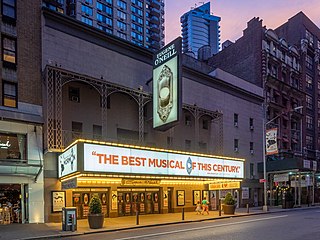
The Eugene O'Neill Theatre, previously the Forrest Theatre and the Coronet Theatre, is a Broadway theater at 230 West 49th Street in the Theater District of Midtown Manhattan in New York City. The theater was designed by Herbert J. Krapp and was constructed for the Shubert brothers. It opened in 1925 as part of a hotel and theater complex named after 19th-century tragedian Edwin Forrest. The modern theater, named in honor of American playwright Eugene O'Neill, has 1,108 seats across two levels and is operated by ATG Entertainment. The auditorium interior is a New York City designated landmark.

The Princess Theatre was a joint venture between the Shubert Brothers, producer Ray Comstock, theatrical agent Elisabeth Marbury and actor-director Holbrook Blinn. Built on a narrow slice of land located at 104–106 West 39th Street, just off Sixth Avenue in New York City, and seating just 299 people, it was one of the smallest Broadway theatres when it opened in early 1913. The architect was William A. Swasey, who designed the Winter Garden Theatre two years earlier.

The Knickerbocker Theatre, previously known as Abbey's Theatre and Henry Abbey's Theatre, was a Broadway theatre located at 1396 Broadway in New York City. It operated from 1893 to 1930. In 1906, the theatre introduced the first moving electrical sign on Broadway to advertise its productions.

The Earl Carroll Theatre was a Broadway theatre at 753 Seventh Avenue near 50th Street in the Theater District of Midtown Manhattan in New York City. Built by impresario Earl Carroll and designed by architect George Keister, it opened on February 25, 1922, and was highly successful for a number of years until it was demolished and rebuilt on a lavish scale. It reopened in August 1931 with Carroll's billing that it was "the largest legitimate theater in the world." However, the facility's operating costs proved astronomical and it went into foreclosure in early 1932 after which it was acquired by producer Florenz Ziegfeld who renamed it the Casino Theatre. The Casino was the site of a very successful revival of Ziegfeld's production of Show Boat in 1932. However, Ziegfeld too went bankrupt only a short time later. The property was auctioned in foreclosure on August 18, 1933 to the Mutual Life Insurance Company for $1 million.

The Irish Repertory Theatre is an Off-Broadway theatre company founded in 1988.
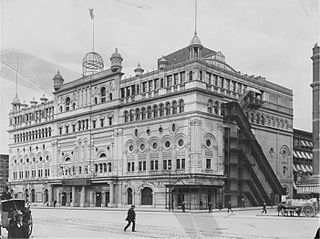
The Olympia Theatre, also known as Hammerstein's Olympia and later the Lyric Theatre and the New York Theatre, was a theater complex built by impresario Oscar Hammerstein I at Longacre Square in Manhattan, New York City, opening in 1895.

The 44th Street Theatre was a Broadway theater at 216 West 44th Street in the Theater District of Manhattan in New York City from 1912 to 1945. It was originally named Weber and Fields' Music Hall when it opened in November 1912 as a resident venue for the comedy duo Weber and Fields, but was renamed to the 44th Street Theatre in December 1913 after their tenure at the theatre ended. It should not be confused with the Weber and Fields' Broadway Music Hall, often referred to as simply Weber and Fields' Music Hall and also known as Weber's Music Hall or Weber's Theatre, which was used by both Weber and Fields or just Weber from 1896 through 1912.

The Casino Theatre was a Broadway theatre located at 1404 Broadway and West 39th Street in New York City. Built in 1882, it was a leading presenter of mostly musicals and operettas until it closed in 1930.
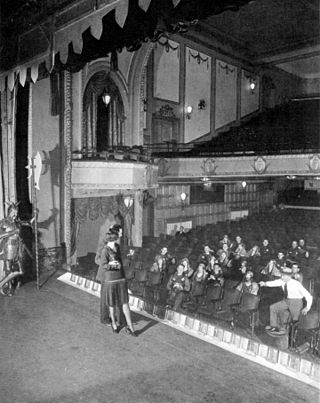
The Vanderbilt Theatre was a New York City Broadway theatre, designed by architect Eugene De Rosa for producer Lyle Andrews. It opened in 1918, located at 148 West 48th Street. The theatre was demolished in 1954.

The Embassy Five Theatre was a Broadway theatre at 1547 Broadway in Times Square, Manhattan, New York City from 1909 until 1982, when it was torn down. It was originally known as the Gaiety Theatre, becoming the Victoria Theatre in 1943; the theater was known as the Embassy Five Theatre for the last two years of its existence.
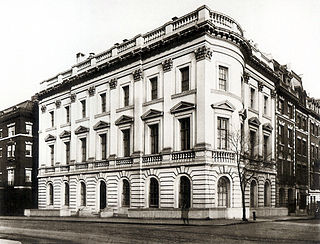
The Mrs. O. H. P. Belmont House was a mansion located at 477 Madison Avenue on the northeast corner of 51st Street in Midtown Manhattan, New York City, New York, United States. The building was demolished in 1951.

Eugene De Rosa was an Italian American architect, named at birth Eugenio. He worked in New York City and specialized in the design of theatres.

Central Theatre was a Broadway theatre in New York City built in 1918. It was located at 1567 Broadway, at the southwest corner with 47th Street, and seated approximately 1,100 patrons. The architect was Herbert J. Krapp. The theatre was built by the Shubert family on a site previously occupied by the Mathushek & Son piano factory.

Madge Carr Cook (1856–1933) was an English-born American stage actress.
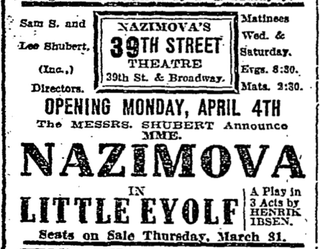
The 39th Street Theatre was a playhouse in New York City located at the corner of 39th Street and Broadway. Originally called Nazimova's 39th Street Theatre after the actress Alla Nazimova, it was in operation from 1910 to 1925 when it was demolished to make way for an office building. Throughout its existence, it was owned by the Shubert family. Its architect was William Albert Swasey, who had designed or remodelled several other Broadway theatres for the family.

Nora Bayes was an American singer and vaudeville performer who was popular internationally between the 1900s and 1920s. She is credited with co-writing the song "Shine On, Harvest Moon" and performed many successful songs during the First World War, including "Over There". She was also noted for her independent views and unconventional private life, becoming an early media celebrity. She made over 160 recordings.
Don Hiram Mullally was an American playwright, screenwriter, theatre director, and actor. He penned several plays which were staged on Broadway, beginning with Conscience in 1924. His play The Desert Flower (1924) was adapted into a film in 1925. He also directed many of his own plays on Broadway as well as works by other writers. He wrote the screenplays to three Hollywood films released in 1933, the year that he died. One of these films, Mystery of the Wax Museum, was an important early horror film.
References
- 1 2 3 4 Nicholas Van Hoogstraten (1991). "Norworth Theatre". Lost Broadway Theatres. Princeton Architectural Press. p. 175.
- ↑ Kenneth T. Jackson; Lisa Keller; Nancy Flood, eds. (2010). "Broadway theatres". The Encyclopedia of New York City, Second Edition. Yale University Press. ISBN 9780300182576.
- ↑ "The Final Curtain: De Rosa, Eugene". Billboard . April 27, 1946.
- 1 2 3 4 5 Ken Bloom (2013). "Belmont Theatre". Broadway: An Encyclopedia. Taylor & Francis. pp. 62–63. ISBN 9781135950200.